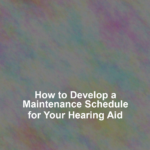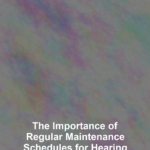Maintaining your hearing aid is like tending a delicate garden; it requires consistent care and attention to thrive. As you rely on it daily to navigate the world of sound, itG??s crucial that you establish a routine that keeps it functioning at its best.
YouG??ve likely invested a significant amount of time and resources into selecting the perfect device, so itG??s imperative you protect that investment with proper upkeep. Daily cleaning practices are just the beginning; thereG??s a symphony of checks and balances that must be performed to ensure your device remains in prime condition.
From weekly moisture checks to bi-annual professional servicing, each step plays a pivotal role in extending the life and performance of your hearing aid. As we explore the key elements of an effective maintenance schedule, youG??ll uncover the lesser-known strategies that can prevent common issues and preserve the clarity of your acoustic experiences.
Stay tuned for insights that could save you the inconvenience of unexpected repairs and the costs associated with premature replacements.
Daily Cleaning Practices
Every day, you should gently brush away any debris from the surface of your hearing aid to ensure optimal performance. ItG??s crucial to maintain the cleanliness of your device not only for functionality but also to prevent any potential infections or irritations in your ear. Use a soft, dry cloth to wipe the body of the hearing aid, being careful not to force any dirt into the microphone ports or other openings.
DonG??t forget the earpiece, as itG??s constantly exposed to earwax and skin oils. A wax pick or loop is often provided to help you remove any accumulated wax from the ear mold or dome. Be gentle to avoid damaging any delicate components.
YouG??ll also need to check the battery compartment. Open it and brush away any visible particles. This helps prevent corrosion and power issues. If you use a rechargeable hearing aid, ensure the charging contacts are clean for efficient power transfer.
Lastly, at the end of each day, open the battery compartment to let any moisture evaporate overnight. Keeping your hearing aid dry extends its life and keeps the sound quality sharp. Stick to these simple steps and youG??ll help your device perform at its best.
Weekly Moisture Checks
While daily cleaning is essential, dedicating time each week to check for moisture ensures your hearing aid works reliably for longer. Moisture can be a silent enemy, gradually affecting your deviceG??s performance. To tackle this, youG??ll need to incorporate weekly moisture checks into your maintenance routine.
Start by inspecting the battery compartment. If you spot any condensation or wetness, itG??s a sign that moistureG??s crept in. Wipe it gently with a dry, soft cloth to remove any traces of liquid. DonG??t forget to check the microphone and speaker areas, as theyG??re equally susceptible to moisture damage.
To prevent future moisture buildup, consider using a dehumidifier designed for hearing aids. Once a week, place your hearing aid inside the dehumidifier overnight. This device will draw out the moisture, preserving the intricate electronics inside.
Monthly Sound Quality Tests
To ensure your hearing aid delivers optimal performance, conduct sound quality tests monthly. ItG??s not just about keeping it clean; youG??ve got to make sure it sounds right, too. HereG??s how you can check the sound quality to ensure your device is working at its best:
-
Listen for Consistency: Wear your hearing aid in a familiar environment and listen to everyday sounds. They should be clear and consistent. Note any changes in audio quality, like crackling or distortion.
-
Test Different Settings: If your device has multiple settings or programs, cycle through them. Make sure each one functions as intended and that transitions between settings are smooth.
-
Check the Microphone: Rub your finger gently over the microphone to create a soft sound. You should hear it clearly. If the sound is muffled or absent, the microphone may need cleaning or repair.
-
Phone Test: Make a phone call to a trusted friend or family member. Ask for feedback on how clear your voice sounds to them. This tests both the microphone and the speaker components of your hearing aid.
Bi-Annual Professional Servicing
Aside from monthly checks, itG??s essential to have your hearing aid professionally serviced twice a year to catch any underlying issues that simple at-home tests might miss. You might wonder why this is important. Well, think of it as taking your car for a check-up; itG??s about ensuring everythingG??s running smoothly and preventing bigger problems down the road.
During these visits, a professional will thoroughly clean your device, much more meticulously than you can at home. TheyG??ll get into all the nooks and crannies, removing any earwax or debris that could affect performance. TheyG??ll also replace any worn out parts that you mightnG??t even realize are due for a change, like tubing or filters.
TheyG??ll conduct a series of tests to ensure your hearing aid is functioning at its best. This isnG??t just about volume; itG??s about clarity, balance, and how well your device is calibrated to your specific hearing needs. If there are any updates or adjustments needed, they can handle them on the spot.
Annual Performance Evaluation
Once a year, itG??s crucial to conduct a comprehensive performance evaluation of your hearing aid to ensure it meets your hearing requirements accurately. Your hearing can change over time, and so can the functionality of your device. This yearly check-up is the perfect opportunity to make sure everythingG??s in sync and working at its best for you.
HereG??s what you should expect during your annual performance evaluation:
-
Hearing Test Update: Your audiologist will likely start with a hearing test to check for any changes in your hearing levels. This helps to determine if your hearing aid needs adjusting.
-
Device Inspection: The physical condition of your hearing aid will be examined closely for any signs of wear or damage that could affect performance.
-
Cleaning and Maintenance: Even if youG??ve been diligent with your daily cleaning routine, your hearing aid will get a thorough cleaning to remove any buildup you mightG??ve missed.
-
Programming Adjustments: Based on the results of your hearing test and the inspection of your device, your audiologist may reprogram your hearing aid to tailor its performance to your current hearing needs.
Conclusion
YouG??ve got this! Stick to daily cleaning to keep earwax at bay, and donG??t forget those weekly moisture checks to prevent damage.
Test the sound monthly to ensure everythingG??s crystal clear.
Swing by your audiologist every six months for a pro tune-up, and cap off the year with a thorough performance evaluation.
Follow this routine, and your hearing aid will stay in top shape, just like you. Keep hearing your bestG??itG??s easy when you maintain right!










